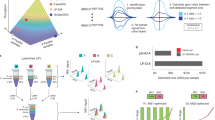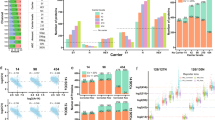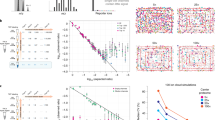Abstract
Accurate quantification of protein expression in biological systems is an increasingly important part of proteomics research. Incorporation of differential stable isotopes in samples for relative protein quantification has been widely used. Stable isotope incorporation at the peptide level using dimethyl labeling is a reliable, cost-effective and undemanding procedure that can be easily automated and applied in high-throughput proteomics experiments. Although alternative multiplex quantitative proteomics approaches introduce isotope labels at the organism level ('stable isotope labeling by amino acids in cell culture' (SILAC)) or enable the simultaneous analysis of eight samples (isobaric tagging for relative and absolute quantification (iTRAQ)), stable isotope dimethyl labeling is advantageous in that it uses inexpensive reagents and is applicable to virtually any sample. We describe in-solution, online and on-column protocols for stable isotope dimethyl labeling of sample amounts ranging from sub-micrograms to milligrams. The labeling steps take approximately 60–90 min, whereas the full protocol including digestion and (two-dimensional) liquid chromatography-mass spectrometry takes approximately 1.5–3 days to complete.
This is a preview of subscription content, access via your institution
Access options
Subscribe to this journal
Receive 12 print issues and online access
$259.00 per year
only $21.58 per issue
Buy this article
- Purchase on Springer Link
- Instant access to full article PDF
Prices may be subject to local taxes which are calculated during checkout





Similar content being viewed by others
References
Bantscheff, M., Schirle, M., Sweetman, G., Rick, J. & Kuster, B. Quantitative mass spectrometry in proteomics: a critical review. Anal. Bioanal. Chem. 389, 1017–1031 (2007).
Ong, S.E. & Mann, M. Mass spectrometry-based proteomics turns quantitative. Nat. Chem. Biol. 1, 252–262 (2005).
Heck, A.J.R. & Krijgsveld, J. Mass spectrometry-based quantitative proteomics. Expert Rev. Proteomics 1, 317–326 (2004).
Ong, S.E. & Mann, M. A practical recipe for stable isotope labeling by amino acids in cell culture (SILAC). Nat. Protoc. 1, 2650–2660 (2006).
Shevchenko, A., Tomas, H., Havlis, J., Olsen, J.V. & Mann, M. In-gel digestion for mass spectrometric characterization of proteins and proteomes. Nat. Protoc. 1, 2856–2860 (2006).
Shiio, Y. & Aebersold, R. Quantitative proteome analysis using isotope-coded affinity tags and mass spectrometry. Nat. Protoc. 1, 139–145 (2006).
Munchbach, M., Quadroni, M., Miotto, G. & James, P. Quantitation and facilitated de novo sequencing of proteins by isotopic N-terminal labeling of peptides with a fragmentation-directing moiety. Anal. Chem. 72, 4047–4057 (2000).
Staes, A. et al. Improved recovery of proteome-informative, protein N-terminal peptides by combined fractional diagonal chromatography (COFRADIC). Proteomics 8, 1362–1370 (2008).
Blagoev, B., Ong, S.E., Kratchmarova, I. & Mann, M. Temporal analysis of phosphotyrosine-dependent signaling networks by quantitative proteomics. Nat. Biotech. 22, 1139–1145 (2004).
Harsha, H.C., Molina, H. & Pandey, A. Quantitative proteomics using stable isotope labeling with amino acids in cell culture. Nat. Protoc. 3, 505–516 (2008).
Ross, P.L. et al. Multiplexed protein quantitation in Saccharomyces cerevisiae using amine-reactive isobaric tagging reagents. Mol. Cell Proteomics 3, 1154–1169 (2004).
Pierce, A. et al. Eight-channel iTRAQ enables comparison of the activity of six leukemogenic tyrosine kinases. Mol. Cell Proteomics 7, 853–863 (2008).
Hsu, J.L., Huang, S.Y., Chow, N.H. & Chen, S.H. Stable-isotope dimethyl labeling for quantitative proteomics. Anal. Chem. 75, 6843–6852 (2003).
Boersema, P.J., Aye, T.T., Van Veen, T.A.B., Heck, A.J.R. & Mohammed, S. Triplex protein quantification based on stable isotope labeling by peptide dimethylation applied to cell and tissue lysates. Proteomics 8, 4624–4632 (2008).
Raijmakers, R. et al. Automated online sequential isotope labeling for protein quantitation applied to proteasome tissue-specific diversity. Mol. Cell Proteomics 7, 1755–1762 (2008).
Hsu, J.L., Huang, S.Y., Shiea, J.T., Huang, W.Y. & Chen, S.H. Beyond quantitative proteomics: signal enhancement of the a(1) ion as a mass tag for peptide sequencing using dimethyl labeling. J. Proteome Res. 4, 101–108 (2005).
Hsu, J.L., Huang, S.Y. & Chen, S.H. Dimethyl multiplexed labeling combined with microcolumn separation and MS analysis for time course study in proteomics. Electrophoresis 27, 3652–3660 (2006).
Hsu, J.L., Chen, S.H., Li, D.T. & Shi, F.K. Enhanced a(1) fragmentation for dimethylated proteins and its applications for N-terminal identification and comparative protein quantitation. J. Proteome Res. 6, 2376–2383 (2007).
Shen, P.T., Hsu, J.L. & Chen, S.H. Dimethyl isotope-coded affinity selection for the analysis of free and blocked N-termini of proteins using LC-MS/MS. Anal. Chem. 79, 9520–9530 (2007).
Lemeer, S. et al. Comparative phosphoproteomics of zebrafish Fyn/Yes morpholino knockdown embryos. Mol. Cell Proteomics 7, 2176–2187 (2008).
Kwok, M.C.M., Holopainen, J.M., Molday, L.L., Foster, L.J. & Molday, R.S. Proteomics of photoreceptor outer segments identifies a subset of SNARE and Rab proteins implicated in membrane vesicle trafficking and fusion. Mol. Cell Proteomics 7, 1053–1066 (2008).
Ji, C., Li, L., Gebre, M., Pasdar, M. & Li, L. Identification and quantification of differentially expressed proteins in E-Cadherin deficient SCC9 cells and SCC9 transfectants expressing E-Cadherin by dimethyl isotope labeling, LC-MALDI MS and MS/MS. J. Proteome Res. 4, 1419–1426 (2005).
Synowsky, S.A., van Wijk, M., Raijmakers, R. & Heck, A.J.R. Comparative multiplexed mass spectrometric analyses of the endogenously expressed yeast nuclear and cytoplasmic exosome. J. Mol. Biol. 385, 1300–1313 (2009).
Van Hoof, D. et al. An experimental correction for arginine-to-proline conversion artifacts in SILAC-based quantitative proteomics. Nat. Methods 4, 677–678 (2007).
Klammer, A.A. & MacCoss, M.J. Effects of modified digestion schemes on the identification of proteins from complex mixtures. J. Proteome Res. 5, 695–700 (2006).
Pinkse, M.W.H., Uitto, P.M., Hilhorst, M.J., Ooms, B. & Heck, A.J.R. Selective isolation at the femtomole level of phosphopeptides from proteolytic digests using 2D-nanoLC-ESI-MS/MS and titanium oxide precolumns. Anal. Chem. 76, 3935–3943 (2004).
Huang, S.Y. et al. Quantitation of protein phosphorylation in pregnant rat uteri using stable isotope dimethyl labeling coupled with IMAC. Proteomics 6, 1722–1734 (2006).
Perkins, D.N., Pappin, D.J.C., Creasy, D.M. & Cottrell, J.S. Probability-based protein identification by searching sequence databases using mass spectrometry data. Electrophoresis 20, 3551–3567 (1999).
Eng, J.K., McCormack, A.L. & Yates, J.R. An approach to correlate tandem mass-spectral data of peptide with amino-acid-sequence in a protein database. J. Am. Soc. Mass Spectrom. 5, 976–989 (1994).
Colinge, J., Masselot, A., Giron, M., Dessingy, T. & Magnin, J. OLAV: towards high-throughput tandem mass spectrometry data identification. Proteomics 3, 1454–1463 (2003).
Craig, R. & Beavis, R.C. TANDEM: matching proteins with tandem mass spectra. Bioinformatics 20, 1466–1467 (2004).
Bradford, M.M. A rapid and sensitive method for the quantitation of microgram quantities of protein utilizing the principle of protein–dye binding. Anal. Biochem. 72, 248–254 (1976).
Nagele, E., Vollmer, M., Horth, P. & Vad, C. 2D-LC/MS techniques for the identification of proteins in highly complex mixtures. Expert Rev. Proteomics 1, 37–46 (2004).
Pinkse, M.W.H. et al. Highly robust, automated, and sensitive on line TiO2-based phosphoproteomics applied to study endogenous phosphorylation in Drosophila melanogaster . J. Proteome Res. 7, 687–697 (2008).
Ji, C. & Li, L. Quantitative proteome analysis using differential stable isotopic labeling and microbore LC-MALDI MS and MS/MS. J. Proteome Res. 4, 734–742 (2005).
Ji, C., Lo, A., Marcus, S. & Li, L. Effect of 2MEGA labeling on membrane proteome analysis using LC-ESI QTOF MS. J. Proteome Res. 5, 2567–2576 (2006).
Ji, C., Guo, N. & Li, L. Differential dimethyl labeling of N-termini of peptides after guanidination for proteome analysis. J. Proteome Res. 4, 2099–2108 (2005).
Khidekel, N. et al. Probing the dynamics of O-GlcNAc glycosylation in the brain using quantitative proteomics. Nat. Chem. Biol. 3, 339–348 (2007).
Guo, K., Ji, C. & Li, L. Stable-isotope dimethylation labeling combined with LC-ESI MS for quantification of amine-containing metabolites in biological samples. Anal. Chem. 79, 8631–8638 (2007).
Rogers, L.D. & Foster, L.J. The dynamic phagosomal proteome and the contribution of the endoplasmic reticulum. Proc. Natl. Acad. Sci. USA 104, 18520–18525 (2007).
Aye, T.T. et al. Selectivity in enrichment of PKA RI and RII isoforms and their interactors using modified cAMP affinity resins. Mol. Cell. Proteomics (in press).
Rappsilber, J., Mann, M. & Ishihama, Y. Protocol for micro-purification, enrichment, pre-fractionation and storage of peptides for proteomics using StageTips. Nat. Protoc. 2, 1896–1906 (2007).
Acknowledgements
We thank Ms Sharon Gauci for critically reviewing this paper. This study was supported by The Netherlands Proteomics Centre (http://www.netherlandsproteomicscentre.nl/).
Author information
Authors and Affiliations
Corresponding authors
Rights and permissions
About this article
Cite this article
Boersema, P., Raijmakers, R., Lemeer, S. et al. Multiplex peptide stable isotope dimethyl labeling for quantitative proteomics. Nat Protoc 4, 484–494 (2009). https://doi.org/10.1038/nprot.2009.21
Published:
Issue Date:
DOI: https://doi.org/10.1038/nprot.2009.21
This article is cited by
-
Biological big-data sources, problems of storage, computational issues, and applications: a comprehensive review
Knowledge and Information Systems (2024)
-
Proteomic analysis of neonatal mouse hearts shows PKA functions as a cardiomyocyte replication regulator
Proteome Science (2023)
-
PI3K-AKT activation resculpts integrin signaling to drive filamentous tau-induced proinflammatory astrogliosis
Cell & Bioscience (2023)
-
Golgi fucosyltransferase 1 reveals its important role in α-1,4-fucose modification of N-glycan in CRISPR/Cas9 diatom Phaeodactylum tricornutum
Microbial Cell Factories (2023)
-
Economical synthesis of γ-cyclodextrin catalyzed by oriented cyclodextrin glycosyltransferase displayed on bacterial polyhydroxyalkanoate nanogranules
Microbial Cell Factories (2023)
Comments
By submitting a comment you agree to abide by our Terms and Community Guidelines. If you find something abusive or that does not comply with our terms or guidelines please flag it as inappropriate.



